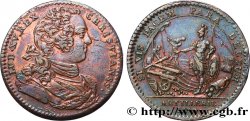fjt_013145 - ARTILLERY Louis de Crevant, duc de Humières, grand maître de l’Artillerie 1694
Quantity
Add to your cart

Type : Louis de Crevant, duc de Humières, grand maître de l’Artillerie
Date: 1694
Metal : silver
Diameter : 27,2 mm
Orientation dies : 6 h.
Edge : lisse
Rarity : R1
Catalogue references :
Obverse
Obverse legend : LE MARECHAL DE HVMIERES.
Obverse description : Écu aux armes de Louis de Crevant (1632-1694), marquis puis duc de Humières portent écartelé ; aux 1 et 4, contre-écartelé d’argent et d’azur ; aux 2 et 3, d’argent fretté de sable, dessous, deux canons.
Reverse
Reverse legend : FLAMMIFERO VOMIT ORE MORTEM ; À L'EXERGUE : ARTILLERIE 1694.
Reverse description : Canon tirant.
Reverse translation : Il crache la mort par sa gueule de feu.
Commentary
Gouverneur de Compiègne en 1646, en survivance de son père, Louis de Crevant est maréchal de camp en 1650 en Flandre. En 1660, il est gouverneur du Bourbonnais puis, protégé par Louvois, reste en Flandre entre 1667 et 1675. Il seconde Turenne et devient gouverneur de Lille et maréchal de France en 1668. En Hollande en 1675, il devient gouverneur du Hainaut puis Grand maître de l’artillerie en 1685 (il avait le droit de faire supporter ses armes par deux canons adossés avec leurs affûts au naturel, voyez le droit de ce jeton). Chevalier des ordres du roi en 1688, il devient duc et pair de France en 1690. Il se retire en 1691 et meurt à Versailles. Plus que ses succès, c’est son épouse, la belle et riche Louise Antoinette de la Châtre, dame du palais de la Reine qui passe pour avoir contribué à sa réussite..








 Report a mistake
Report a mistake Print the page
Print the page Share my selection
Share my selection Ask a question
Ask a question Consign / sell
Consign / sell
 Full data
Full data



